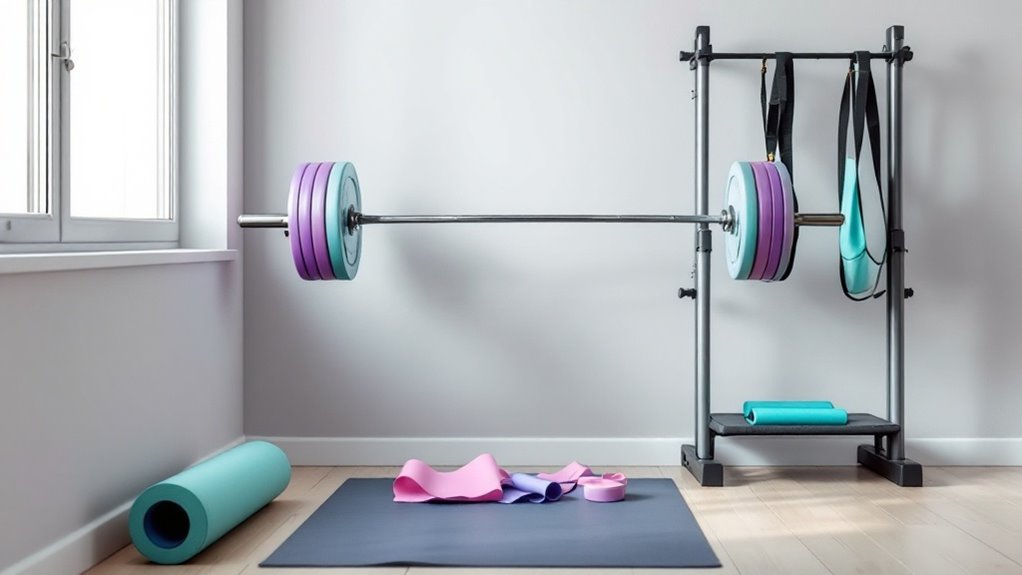Weight Lifting Plans for Women

Women's weight lifting plans combine strategic resistance training with proper form and progressive overload principles. A successful program includes 3-4 weekly strength sessions, focusing initially on full-body workouts with fundamental movements. Essential equipment spans proper shoes, moisture-wicking attire, and basic weights. Beginners should master bodyweight exercises before advancing to weighted movements. Safety and technique fundamentals establish the foundation for sustainable strength gains and ideal fitness transformation.
Key Takeaways
- Begin with full-body workouts three times per week, focusing on fundamental movements and proper form before increasing weights.
- Include a mix of compound exercises (squats, deadlifts, bench press) and isolation movements for balanced muscle development.
- Start with 3 sets of 8-12 repetitions per exercise, using weights that challenge you while maintaining proper technique.
- Schedule rest days between workouts to allow proper muscle recovery and prevent overtraining or injury.
- Progress gradually by increasing weight, sets, or repetitions once current exercises become manageable with perfect form.
Essential Equipment and Gear for Women's Weight Training

Before beginning a weight training journey, women need to assemble the proper equipment and gear that will support their strength goals and guarantee both safety and progress.
Essential items include proper athletic shoes with strong arch support, moisture-wicking workout clothes, and weight lifting gloves to protect hands.
Basic equipment requirements include resistance bands, a yoga mat, and adjustable dumbbells for beginners. As strength increases, adding a weight bench and barbell set becomes vital.
Sports bras providing maximum support are non-negotiable, while a gym bag, water bottle, and lifting belt round out the foundational gear needed for effective training.
Following progressive overload principles helps women systematically increase strength without risking injury or plateaus in their training.
Beginner's Guide to Proper Form and Technique

Mastering proper form and technique serves as the foundation for any successful weight training program.
When women begin weight training, focusing on fundamental movement patterns guarantees safety and enhances results. Key principles include maintaining a neutral spine, engaging the core, and controlling breathing throughout each exercise.
For compound movements like squats and deadlifts, proper hip hinge mechanics and knee tracking are essential. Upper body exercises require shoulder stability and scapular control.
Starting with bodyweight exercises allows beginners to perfect form before adding external resistance.
Recording videos of training sessions helps identify areas for improvement and guarantees consistent progression in technique development.
Following a structured progressive overload approach ensures continued strength gains while maintaining proper form.
Weekly Workout Plans for Different Fitness Goals

Once proper form and technique become second nature, women can optimize their weight training efforts through structured weekly workout plans tailored to their specific fitness goals.
Different objectives require distinct training approaches – muscle building demands heavy weights with lower reps, while toning focuses on moderate weights with higher repetitions. Fat loss programs typically combine compound exercises with shorter rest periods.
A well-designed weekly plan includes 3-4 strength training sessions, targeting major muscle groups with appropriate rest days. For beginners, full-body workouts three times per week prove effective, while intermediate lifters may benefit from upper/lower body splits or push/pull routines.
Regular strength training helps women achieve increased bone density while maintaining lean muscle mass and a healthy metabolic rate.
Common Mistakes to Avoid and Safety Tips

Many aspiring female weightlifters unknowingly sabotage their progress by falling into common training pitfalls that can lead to injury or stalled results. Proper form, strategic rest periods, and gradual progression are essential elements for safe, effective training.
- Skipping proper warm-ups and rushing through exercises, which increases injury risk and compromises muscle involvement.
- Using momentum instead of controlled movements, reducing exercise effectiveness and potentially straining joints.
- Neglecting proper breathing techniques during lifts, which can lead to increased blood pressure and decreased stability.
Understanding these mistakes helps women optimize their training while staying safe. Establishing solid fundamentals creates a foundation for sustainable progress and long-term success in weightlifting. Combining weightlifting with high-intensity interval training can accelerate fitness results while building lean muscle mass.
Frequently Asked Questions
How Long Should I Rest Between Weight Training Sessions?
Rest periods between weight training sessions typically range from 24-48 hours for the same muscle groups. This allows proper muscle recovery and prevents overtraining.
Full-body workouts require longer rest periods, while split routines enable training different muscle groups on consecutive days.
Beginners should start with 48-hour rest intervals, while advanced lifters may adjust based on their recovery capacity and workout intensity.
Can Weight Lifting Affect My Menstrual Cycle?
Weight training can impact menstrual cycles through hormonal changes and stress responses in the body.
Intense lifting may cause temporary cycle irregularities, especially when combined with significant changes in body composition or low body fat percentage.
However, moderate strength training typically helps regulate cycles and reduces PMS symptoms.
Tracking both training intensity and menstrual patterns allows for ideal program adjustments and hormone balance.
Should I Take Protein Supplements While Weight Training?
While some believe protein shakes are just expensive flavored water, these supplements can be valuable training allies.
Research shows adequate protein intake supports muscle recovery and growth during resistance training. For ideal results, athletes should consume 1.6-2.2g of protein per kg of body weight daily.
Quality protein supplements can help meet these requirements when whole food sources aren't readily available or practical.
Will Lifting Weights Make Me Look Too Muscular or Bulky?
Most women won't develop excessive muscle bulk from weight training due to naturally lower testosterone levels.
Building significant muscle mass requires specific training protocols, strict nutrition plans, and often supplementation.
Regular weight training typically results in a lean, toned physique.
Even professional female athletes who train intensively maintain feminine physiques.
The body responds to resistance training by becoming stronger and more defined, not necessarily larger.
Can I Continue Weight Training During Pregnancy?
Research shows that 80% of pregnant women who maintained a regular strength training routine experienced fewer pregnancy-related discomforts.
Weight training during pregnancy is generally safe when properly modified and approved by healthcare providers.
Key modifications include reducing weight loads, avoiding exercises while lying flat on the back after the first trimester, and focusing on proper form.
Regular monitoring and adjusting the routine as pregnancy progresses is essential.
Final Thoughts
With dedication and proper guidance, women can transform their fitness journey through weightlifting. Like forging steel into strength, consistent training builds not just muscle, but confidence and resilience. Whether pursuing fat loss, muscle gain, or overall wellness, following structured plans while maintaining proper form creates lasting results. By avoiding common pitfalls and embracing safe training practices, women can achieve their unique fitness goals and access their full potential.


